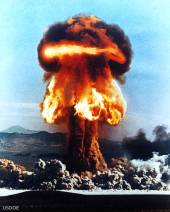With the end of the Cold War and the fall of the Soviet Union, the military doctrine of Mutually Assured Destruction became obsolete. U.S. security was no longer dependent upon a large intercontinental nuclear strike capability. No longer facing any prominent military rival, defense spending began to decrease, and long-range nuclear missiles were dismantled. With no country able to challenge our military authority, no obvious threat was present to encourage investment in defense.
The “War on Terror” appears to have a new role for our most deadly weapon of mass destruction. After 9/11, as the military budget swelled, unpopular programs working with limited resources were suddenly awash in money. Nuclear weapons research and development again became highly active reshaping our nuclear strike capabilities. While live testing of nuclear devices has been suspended since 1992, the world’s fastest super-computers are now dedicated to simulated testing and design. In the near future fission weapons will again be used in combat. Now is a good time to decide how you feel about that.
“In this present context, the United States must retain strategic nuclear forces sufficient to deter any hostile foreign leadership with access to nuclear weapons from acting against our vital interests and to convince such a leadership that seeking a nuclear advantage would be futile. Thus, for the foreseeable future, the United States will continue to need a reliable and flexible nuclear deterrent…” 1
“U.S. nuclear forces, alone are unsuited to most of the contingencies for which the United States prepares. The United States and allied interests may not require nuclear strikes.” A “new mix” of nuclear, non-nuclear, and defensive capabilities “is required for the diverse set of potential adversaries and unexpected threats the United States may confront in the coming decades…Building on the Quadrennial Defense Review this Nuclear Posture Review puts in motion a major change in our approach to the role of nuclear offensive forces in our deterrent strategy and presents the blueprint for transforming our strategic posture…” 2
“Global strike has become one of the core missions for the Omaha-based Strategic Command, or Stratcom. Once, Stratcom oversaw only the nation’s nuclear forces; now it has responsibility for overseeing a global strike plan with both conventional and nuclear options…The global strike plan holds the nuclear option in reserve if intelligence suggests an “imminent” launch of an enemy nuclear strike on the United States or if there is a need to destroy hard-to-reach targets.” 3
